Since my fishing season is on hiatus until I get better cold weather gear or the water temps raise I have been quiet on this board. I decided to pull some info together for anyone that is looking into building rods this winter. I know we have several fine gentlemen on here that bought blanks this year and wanted to dip there feet into the rod building arena so this might help you get started.
Basic Rod Wrapping Jig
Although you can make rods with nothing more than epoxy, thread, a cardboard box and a phone book a simple and cheap rod wrapping jig makes thing much easier.
I threw these plans together for a simple cheap jig. All the materials are readily available from any home improvement store and should cost around $20
Materials List
1 - 1” x 6” x 10’ wood board (Any cheap knot free wood will work) * see note below
18 - small screw eyes (1/2” overall height)
1 - 18” x 1” strip of Velcro (fuzzy side or felt) ** see note below
2 – 1 ½” x ½” compression springs
8 - 1 ¾” wood screws
2 - ¼” wing nuts
2 - ¼” nuts
1 - 12” x ¼” threaded rod (you can cut this down or leave it full length depending on what size thread spools you are using) *** see note below
6 - large ¼” washers
3 - rubber bands **** see note below
10 - anti skid rubber pads ***** see note below
Notes
* You will only use half of this board so you could make two rigs with one piece of lumber and double up on the other materials. If two people go in together you can save a couple bucks.
** This will be used in the V section of the uprights for blank protection. You can use the fuzzy side of the Velcro strip or a strip of felt. I don’t like using felt due to the possibilities of fuzzes getting into the finish while curing. The strip should be cut to size and glued to the V section.
*** Leaving it full length will allow you to use Madeira threads which have 3 ½” spools. You can always add a spacer to take up some room if you are using smaller 100 yard spools. You may also need to decrease the spring length when using larger spools to reduce the tension on the spool.
**** The rubber bands will be used to secure the rod to the uprights via the two screw eyes. The band should be tied to one of the eyes and then passed over the rod and attached to the other eye. You might need to experiment with different size and thickness of bands to get the right tension.
***** 4 of the pads will be used on the corners of the bottom of the main base. 2 will be used at the center point on the bottom of the main base and 4 for the bottom of the support base.
Tools Needed
Saw
Drill
Tape measure
Wood glue
Ruler
Pencil
Counter sink bit
Sandpaper

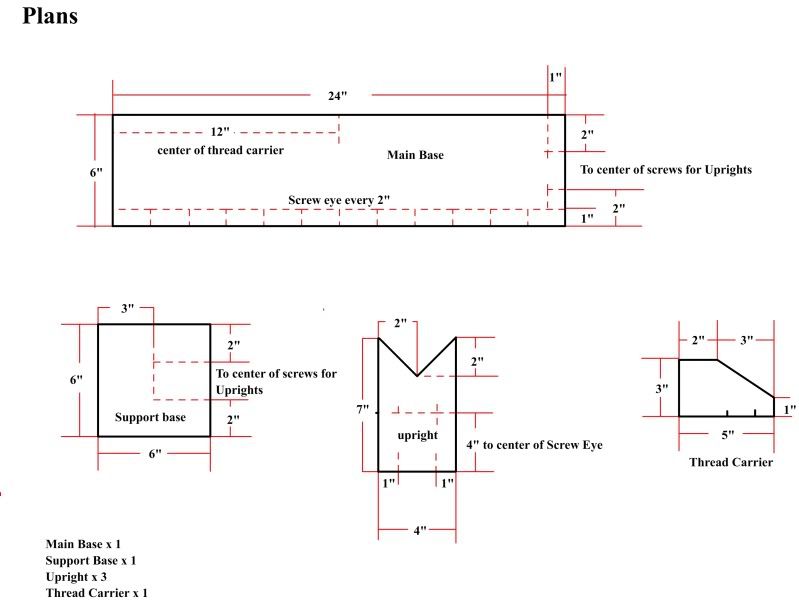
This plan includes the main base consisting of two upright supports, Thread carriage and a separate support base. The separate support base comes into play when working on the upper section of the rod. As an example you would put the handle section of the rod on the support base and move the main base up the rod to work on the guides.
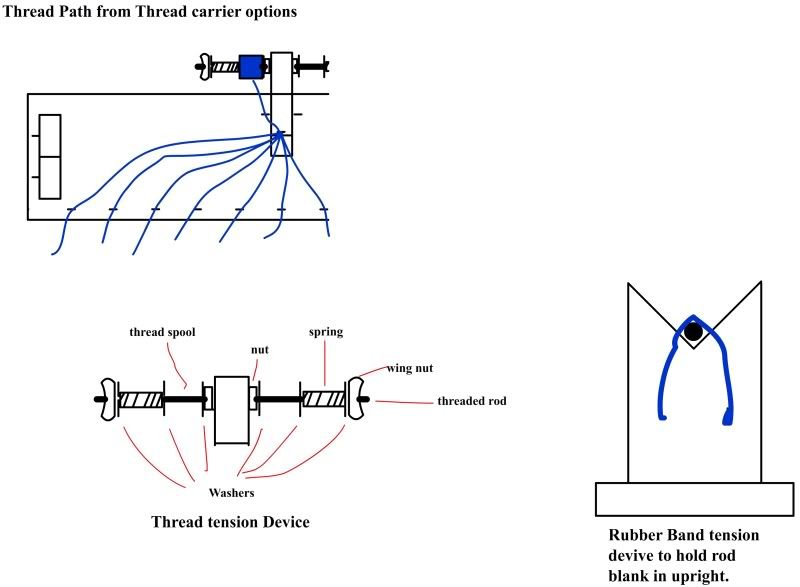
This shows the details of the tension device and thread paths. The tension device ensures a constant tension on the thread spool. You can increase or decrease the tension by adjusting the wing nut. You can also substitute the wing nuts for small binder clips to make changing spools faster.
I would make sure the screw eyes are closed on the thread tension device and a little open on the wrapper base. Leaving the eyes open on the base will allow you to move the thread to another eye without re threading it thru the base eyes. This allows you to change positions while you are wrapping a large area. For more complicated butt wraps (Diamonds, Chevrons, etc...) I would bypass the base eyes and guide the thread by hand. Also make sure there are no burrs on the eyes that can catch or damage the thread. Thread under tension can break with the slightest nick.
Depending on where you place the side eyes on the thread carriage you might have to file or sand down the angled edges to ensure the thread does not touch any sharp edges. You will have to experiment with all the thread paths and fine tune this.
Rubber bands can be used on the uprights secure the rod in the holders.
Tools Needed to Build Rods
The following list of items are helpful when building a rod. They are not necessarily needed but they do make the process easier.
Razor Blades – Single edge blades used in scrapers work great and there cheap. When the blade gets dull to the point of not cutting a thread under tension by touching it to the blade don’t throw it away. Dull the edge good with some sand paper and throw it in another container. These work great for stripping glue or finish off an existing blank if you do any rebuilds in the future.
China Markers – Used for marking the blank when laying components out. If you make a mistake just rub it off with your hand and it’s gone. Be careful marking too heavily on the blank if you are using a thread with any transparence. There will be a possibility of the mark showing thru the thread after the finish is applied. In this case use smaller marks that are less noticeable.
Good Straight Edge – With both standard and metric measurements. This is a must have for fine measurements and layout markings used in butt wraps.
Tape Measure – used for component layout.
Thread Burnishing Tool – Used for burnishing out thread gaps and packing threads.
Thread Pick – Used for moving threads and packing in tight patterns.
Thread snips – Used to cut thread tag ends and general thread/tape cutting
Masking Tape – ½” and 1” wide rolls. It is used for practically everything. Creating arbors, Taping down guides, Taping down threads in butt wraps, protecting the blank/reel seat when sanding or gluing up components. Buy several rolls of each size because you will go thru it quickly.
Small Spatula Set – Great for mixing up epoxy and applying it to the blank for gluing up handles and reel seats. They are cheap, reusable and mix epoxy better than sticks or disposable brushes. The larger versions (1/2” wide) can also be used for applying finish on butt wraps and guides.
Mixing Cups – Used for mixing batches of epoxy. Make sure you get silicon free cups to avoid contaminating the epoxy.
Disposable Brushes – Used for applying finish on the rod. Grab up a bunch of acid brushes in bulk if you find a deal. They are much better than the cheap plastic brushes.
Sand Paper – In various grits used for blank prepping, handle shaping, etc…
The above items and plans will get you into the game on a budget and if the whole process ends up unappealing you are not out any serious coin. I used a similar setup for years and it worked vey well.
I will work on a set of plans for a cheap rod dryer next and post them up here as well.
Good wrapping
Basic Rod Wrapping Jig
Although you can make rods with nothing more than epoxy, thread, a cardboard box and a phone book a simple and cheap rod wrapping jig makes thing much easier.
I threw these plans together for a simple cheap jig. All the materials are readily available from any home improvement store and should cost around $20
Materials List
1 - 1” x 6” x 10’ wood board (Any cheap knot free wood will work) * see note below
18 - small screw eyes (1/2” overall height)
1 - 18” x 1” strip of Velcro (fuzzy side or felt) ** see note below
2 – 1 ½” x ½” compression springs
8 - 1 ¾” wood screws
2 - ¼” wing nuts
2 - ¼” nuts
1 - 12” x ¼” threaded rod (you can cut this down or leave it full length depending on what size thread spools you are using) *** see note below
6 - large ¼” washers
3 - rubber bands **** see note below
10 - anti skid rubber pads ***** see note below
Notes
* You will only use half of this board so you could make two rigs with one piece of lumber and double up on the other materials. If two people go in together you can save a couple bucks.
** This will be used in the V section of the uprights for blank protection. You can use the fuzzy side of the Velcro strip or a strip of felt. I don’t like using felt due to the possibilities of fuzzes getting into the finish while curing. The strip should be cut to size and glued to the V section.
*** Leaving it full length will allow you to use Madeira threads which have 3 ½” spools. You can always add a spacer to take up some room if you are using smaller 100 yard spools. You may also need to decrease the spring length when using larger spools to reduce the tension on the spool.
**** The rubber bands will be used to secure the rod to the uprights via the two screw eyes. The band should be tied to one of the eyes and then passed over the rod and attached to the other eye. You might need to experiment with different size and thickness of bands to get the right tension.
***** 4 of the pads will be used on the corners of the bottom of the main base. 2 will be used at the center point on the bottom of the main base and 4 for the bottom of the support base.
Tools Needed
Saw
Drill
Tape measure
Wood glue
Ruler
Pencil
Counter sink bit
Sandpaper


This plan includes the main base consisting of two upright supports, Thread carriage and a separate support base. The separate support base comes into play when working on the upper section of the rod. As an example you would put the handle section of the rod on the support base and move the main base up the rod to work on the guides.

This shows the details of the tension device and thread paths. The tension device ensures a constant tension on the thread spool. You can increase or decrease the tension by adjusting the wing nut. You can also substitute the wing nuts for small binder clips to make changing spools faster.
I would make sure the screw eyes are closed on the thread tension device and a little open on the wrapper base. Leaving the eyes open on the base will allow you to move the thread to another eye without re threading it thru the base eyes. This allows you to change positions while you are wrapping a large area. For more complicated butt wraps (Diamonds, Chevrons, etc...) I would bypass the base eyes and guide the thread by hand. Also make sure there are no burrs on the eyes that can catch or damage the thread. Thread under tension can break with the slightest nick.
Depending on where you place the side eyes on the thread carriage you might have to file or sand down the angled edges to ensure the thread does not touch any sharp edges. You will have to experiment with all the thread paths and fine tune this.
Rubber bands can be used on the uprights secure the rod in the holders.
Tools Needed to Build Rods
The following list of items are helpful when building a rod. They are not necessarily needed but they do make the process easier.
Razor Blades – Single edge blades used in scrapers work great and there cheap. When the blade gets dull to the point of not cutting a thread under tension by touching it to the blade don’t throw it away. Dull the edge good with some sand paper and throw it in another container. These work great for stripping glue or finish off an existing blank if you do any rebuilds in the future.
China Markers – Used for marking the blank when laying components out. If you make a mistake just rub it off with your hand and it’s gone. Be careful marking too heavily on the blank if you are using a thread with any transparence. There will be a possibility of the mark showing thru the thread after the finish is applied. In this case use smaller marks that are less noticeable.
Good Straight Edge – With both standard and metric measurements. This is a must have for fine measurements and layout markings used in butt wraps.
Tape Measure – used for component layout.
Thread Burnishing Tool – Used for burnishing out thread gaps and packing threads.
Thread Pick – Used for moving threads and packing in tight patterns.
Thread snips – Used to cut thread tag ends and general thread/tape cutting
Masking Tape – ½” and 1” wide rolls. It is used for practically everything. Creating arbors, Taping down guides, Taping down threads in butt wraps, protecting the blank/reel seat when sanding or gluing up components. Buy several rolls of each size because you will go thru it quickly.
Small Spatula Set – Great for mixing up epoxy and applying it to the blank for gluing up handles and reel seats. They are cheap, reusable and mix epoxy better than sticks or disposable brushes. The larger versions (1/2” wide) can also be used for applying finish on butt wraps and guides.
Mixing Cups – Used for mixing batches of epoxy. Make sure you get silicon free cups to avoid contaminating the epoxy.
Disposable Brushes – Used for applying finish on the rod. Grab up a bunch of acid brushes in bulk if you find a deal. They are much better than the cheap plastic brushes.
Sand Paper – In various grits used for blank prepping, handle shaping, etc…
The above items and plans will get you into the game on a budget and if the whole process ends up unappealing you are not out any serious coin. I used a similar setup for years and it worked vey well.
I will work on a set of plans for a cheap rod dryer next and post them up here as well.
Good wrapping
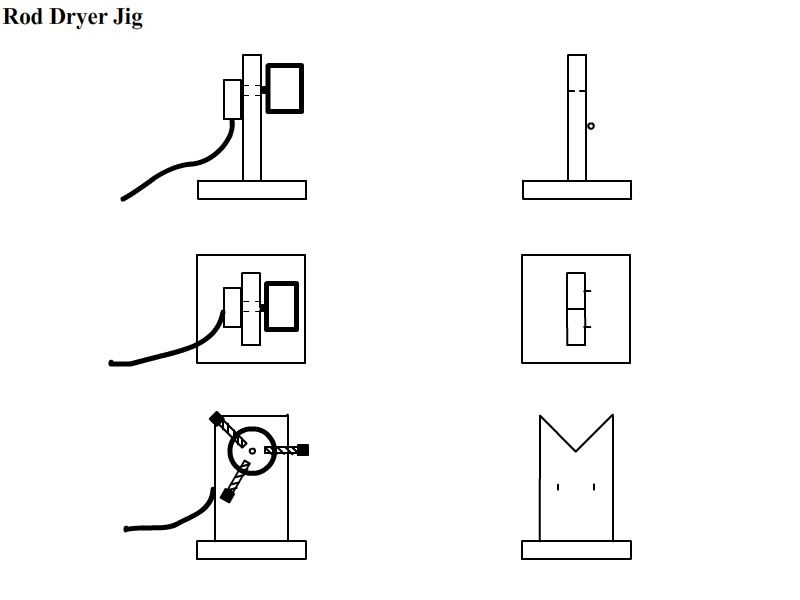
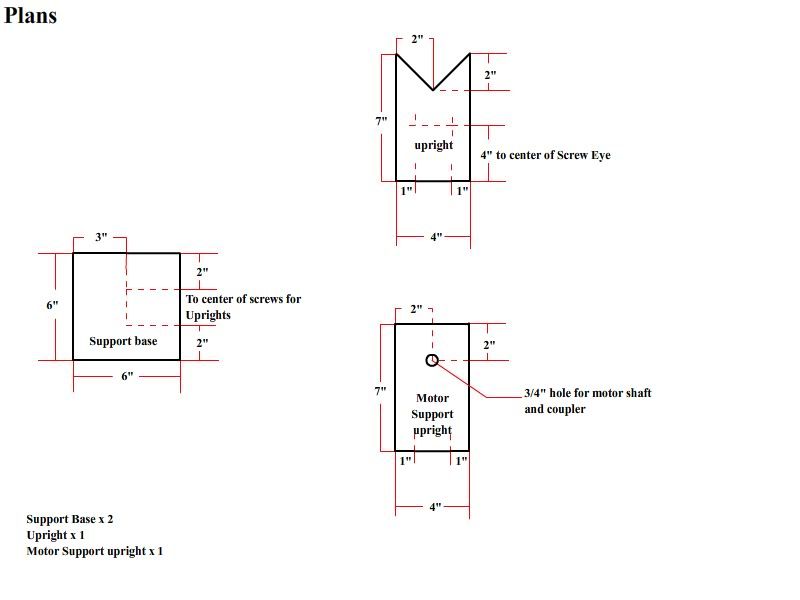

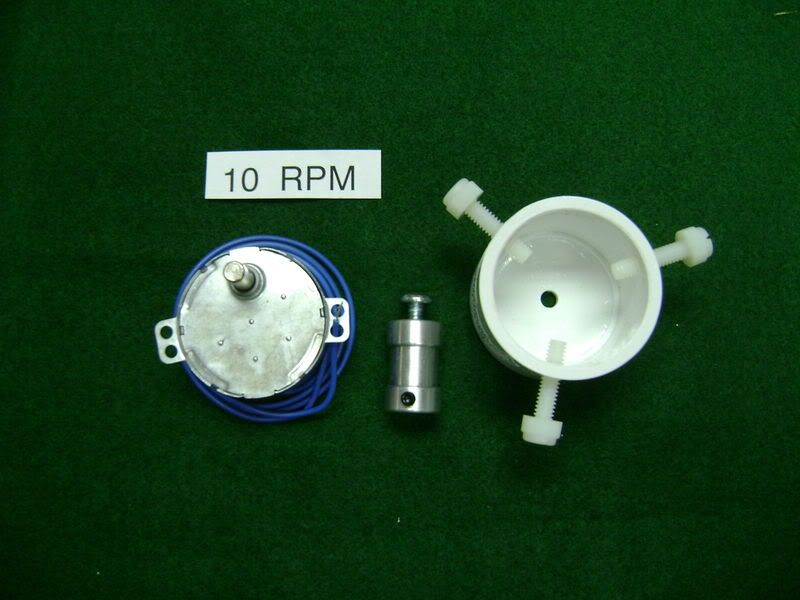


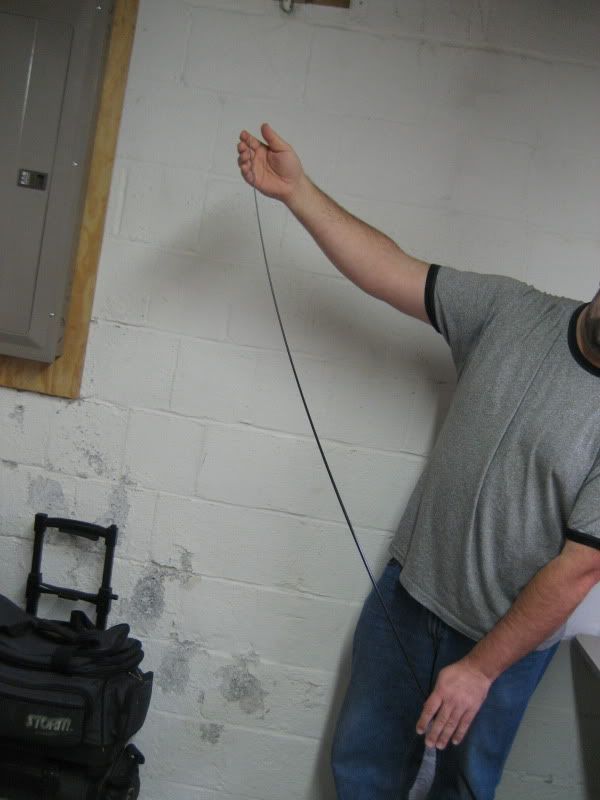

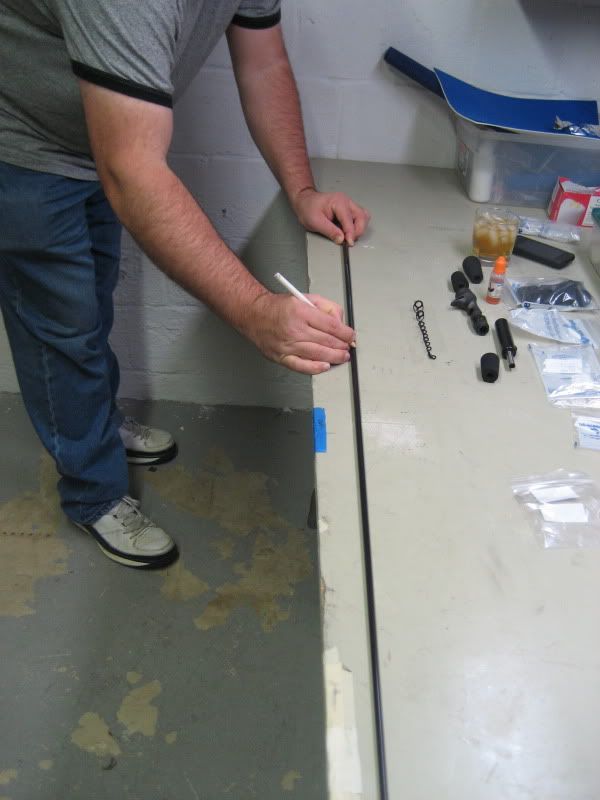
Comment